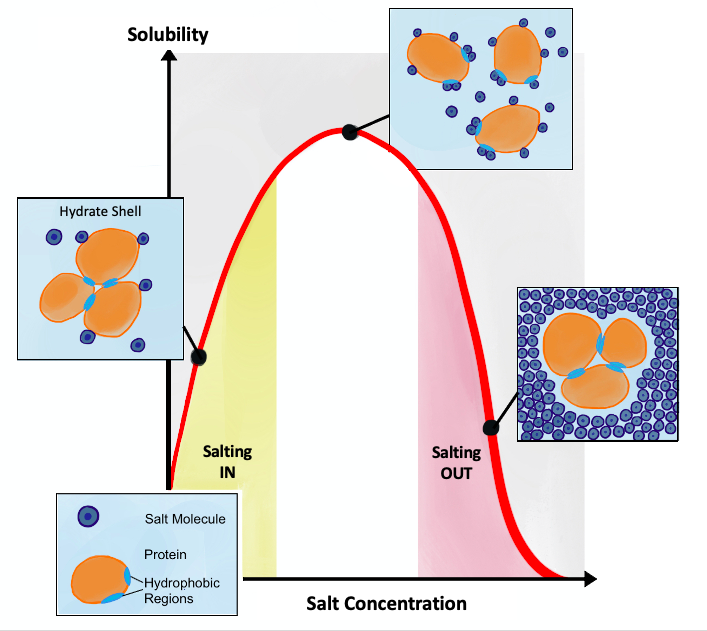|
Salting In
Salting in refers to the effect where increasing the ionic strength of a solution increases the solubility of a solute, such as a protein. This effect tends to be observed at lower ionic strengths. Protein solubility is a complex function of physicochemical nature of the protein, pH, temperature, and the concentration of the salt used. It also depends on whether the salt is kosmotropic, whereby the salt will stabilize water. The solubility of proteins usually increases slightly in the presence of salt, referred to as "salting in". However, at high concentrations of salt, the solubility of the proteins drop sharply and proteins can precipitate out, referred to as "salting out". Anionic interactions Initial salting in at low concentrations is explained by the Debye–Huckel theory. Proteins are surrounded by the salt counterions (ions of opposite net charge) and this screening results in decreasing electrostatic free energy of the protein and increasing activity of the solvent, whi ... [...More Info...] [...Related Items...] OR: [Wikipedia] [Google] [Baidu] |
Ionic Strength
The ionic strength of a solution is a measure of the concentration of ions in that solution. Ionic compounds, when dissolved in water, dissociate into ions. The total electrolyte concentration in solution will affect important properties such as the dissociation constant or the solubility of different salts. One of the main characteristics of a solution with dissolved ions is the ionic strength. Ionic strength can be molar (mol/L solution) or molal (mol/kg solvent) and to avoid confusion the units should be stated explicitly. The concept of ionic strength was first introduced by Lewis and Randall in 1921 while describing the activity coefficients of strong electrolytes. Quantifying ionic strength The molar ionic strength, ''I'', of a solution is a function of the concentration of ''all'' ions present in that solution. :I = \begin\frac\end\sum_^ c_i z_i^ where one half is because we are including both cations and anions, ''c''i is the molar concentration of ion i (M, mol/L), ... [...More Info...] [...Related Items...] OR: [Wikipedia] [Google] [Baidu] |
Solution (chemistry)
In chemistry, a solution is a special type of homogeneous mixture composed of two or more substances. In such a mixture, a solute is a substance dissolved in another substance, known as a solvent. If the attractive forces between the solvent and solute particles are greater than the attractive forces holding the solute particles together, the solvent particles pull the solute particles apart and surround them. These surrounded solute particles then move away from the solid solute and out into the solution. The mixing process of a solution happens at a scale where the effects of chemical polarity are involved, resulting in interactions that are specific to solvation. The solution usually has the state of the solvent when the solvent is the larger fraction of the mixture, as is commonly the case. One important parameter of a solution is the concentration, which is a measure of the amount of solute in a given amount of solution or solvent. The term "aqueous solution" is used when ... [...More Info...] [...Related Items...] OR: [Wikipedia] [Google] [Baidu] |
Solubility
In chemistry, solubility is the ability of a substance, the solute, to form a solution with another substance, the solvent. Insolubility is the opposite property, the inability of the solute to form such a solution. The extent of the solubility of a substance in a specific solvent is generally measured as the concentration of the solute in a saturated solution, one in which no more solute can be dissolved. At this point, the two substances are said to be at the solubility equilibrium. For some solutes and solvents, there may be no such limit, in which case the two substances are said to be " miscible in all proportions" (or just "miscible"). The solute can be a solid, a liquid, or a gas, while the solvent is usually solid or liquid. Both may be pure substances, or may themselves be solutions. Gases are always miscible in all proportions, except in very extreme situations,J. de Swaan Arons and G. A. M. Diepen (1966): "Gas—Gas Equilibria". ''Journal of Chemical Physics'', ... [...More Info...] [...Related Items...] OR: [Wikipedia] [Google] [Baidu] |
Protein
Proteins are large biomolecules and macromolecules that comprise one or more long chains of amino acid residues. Proteins perform a vast array of functions within organisms, including catalysing metabolic reactions, DNA replication, responding to stimuli, providing structure to cells and organisms, and transporting molecules from one location to another. Proteins differ from one another primarily in their sequence of amino acids, which is dictated by the nucleotide sequence of their genes, and which usually results in protein folding into a specific 3D structure that determines its activity. A linear chain of amino acid residues is called a polypeptide. A protein contains at least one long polypeptide. Short polypeptides, containing less than 20–30 residues, are rarely considered to be proteins and are commonly called peptides. The individual amino acid residues are bonded together by peptide bonds and adjacent amino acid residues. The sequence of amino acid residue ... [...More Info...] [...Related Items...] OR: [Wikipedia] [Google] [Baidu] |
Physical Chemistry
Physical chemistry is the study of macroscopic and microscopic phenomena in chemical systems in terms of the principles, practices, and concepts of physics such as motion, energy, force, time, thermodynamics, quantum chemistry, statistical mechanics, analytical dynamics and chemical equilibria. Physical chemistry, in contrast to chemical physics, is predominantly (but not always) a supra-molecular science, as the majority of the principles on which it was founded relate to the bulk rather than the molecular or atomic structure alone (for example, chemical equilibrium and colloids). Some of the relationships that physical chemistry strives to resolve include the effects of: # Intermolecular forces that act upon the physical properties of materials ( plasticity, tensile strength, surface tension in liquids). # Reaction kinetics on the rate of a reaction. # The identity of ions and the electrical conductivity of materials. # Surface science and electrochemistry of cell membrane ... [...More Info...] [...Related Items...] OR: [Wikipedia] [Google] [Baidu] |
Kosmotropic
Co-solvents (in water solvent) are defined as kosmotropic (order-making) if they contribute to the stability and structure of water-water interactions. In contrast, chaotropic (disorder-making) agents have the opposite effect, disrupting water structure, increasing the solubility of nonpolar solvent particles, and destabilizing solute aggregates. Kosmotropes cause water molecules to favorably interact, which in effect stabilizes intramolecular interactions in macromolecules such as proteins. Ionic kosmotropes Ionic kosmotropes tend to be small or have high charge density. Some ionic kosmotropes are , , , , , and . Large ions or ions with low charge density (such as , , , ) instead act as chaotropes. Kosmotropic anions are more polarizable and hydrate more strongly than kosmotropic cations of the same charge density. A scale can be established if one refers to the Hofmeister series or looks up the free energy of hydrogen bonding (\Delta G_) of the salts, which quanti ... [...More Info...] [...Related Items...] OR: [Wikipedia] [Google] [Baidu] |
Counterion
160px, Polystyrene sulfonate, a cation-exchange resin, is typically supplied with as the counterion.">cation-exchange_resin.html" ;"title="Polystyrene sulfonate, a cation-exchange resin">Polystyrene sulfonate, a cation-exchange resin, is typically supplied with as the counterion. In chemistry, a counterion (sometimes written as "counter ion", pronounced as such) is the ion that accompanies an Ionic compound, ionic species in order to maintain Electric charge, electric neutrality. In table salt (NaCl, also known as sodium chloride) the sodium ion (positively charged) is the counterion for the chloride ion (negatively charged) and vice versa. A counterion will be more commonly referred to as an anion or a cation, depending on whether it is negatively or positively charged. Thus, the counterion to an anion will be a cation, and vice versa. In biochemistry, counterions are generally vaguely defined. Depending on their charge, proteins are associated with a variety of smaller ani ... [...More Info...] [...Related Items...] OR: [Wikipedia] [Google] [Baidu] |
John Gamble Kirkwood
John "Jack" Gamble Kirkwood (May 30, 1907, Gotebo, Oklahoma – August 9, 1959, New Haven, Connecticut) was a noted chemist and physicist, holding faculty positions at Cornell University, the University of Chicago, California Institute of Technology, and Yale University. Early life and background Kirkwood was born in Gotebo, Oklahoma, the oldest child of John Millard and Lillian Gamble Kirkwood. His father was educated as an attorney and was a distributor for the Goodyear Corporation in the state of Kansas. In addition to Jack Kirkwood, there were two younger sisters: Caroline (1910) and Margaret (1921). In 1909, the family moved to Wichita, Kansas. In the 1920s the family traveled to Pasadena, California to escape Midwestern winters. Education While in Pasadena, Kirkwood, age 15, audited chemistry classes at Caltech. Showing remarkable talent in mathematics and chemistry, Kirkwood was persuaded by A. A. Noyes to enroll at Caltech before finishing his high school education ... [...More Info...] [...Related Items...] OR: [Wikipedia] [Google] [Baidu] |
Salting Out
Salting out (also known as salt-induced precipitation, salt fractionation, anti-solvent crystallization, precipitation crystallization, or drowning out) is a purification technique that utilizes the reduced solubility of certain molecules in a solution of very high ionic strength. Salting out is typically used to precipitate large biomolecules, such as proteins or DNA. Because the salt concentration needed for a given protein to precipitate out of the solution differs from protein to protein, a specific salt concentration can be used to precipitate a target protein. This process is also used to concentrate dilute solutions of proteins. Dialysis can be used to remove the salt if needed. Principle Salt compounds dissociate in aqueous solutions. This property is exploited in the process of salting out. When the salt concentration is increased, some of the water molecules are attracted by the salt ions, which decreases the number of water molecules available to interact with the c ... [...More Info...] [...Related Items...] OR: [Wikipedia] [Google] [Baidu] |
Solvation Shell
A solvation shell or solvation sheath is the solvent interface of any chemical compound or biomolecule that constitutes the solute. When the solvent is water it is called a hydration shell or hydration sphere. The number of solvent molecules surrounding each unit of solute is called the hydration number of the solute. A classic example is when water molecules arrange around a metal ion. If the metal ion is a cation, the electronegative oxygen atom of the water molecule would be attracted electrostatically to the positive charge on the metal ion. The result is a solvation shell of water molecules that surround the ion. This shell can be several molecules thick, dependent upon the charge of the ion, its distribution and spatial dimensions. A number of molecules of solvent are involved in the solvation shell around anions and cations from a dissolved salt in a solvent. Metal ions in aqueous solutions form metal aquo complexes. This number can be determined by various methods like c ... [...More Info...] [...Related Items...] OR: [Wikipedia] [Google] [Baidu] |



